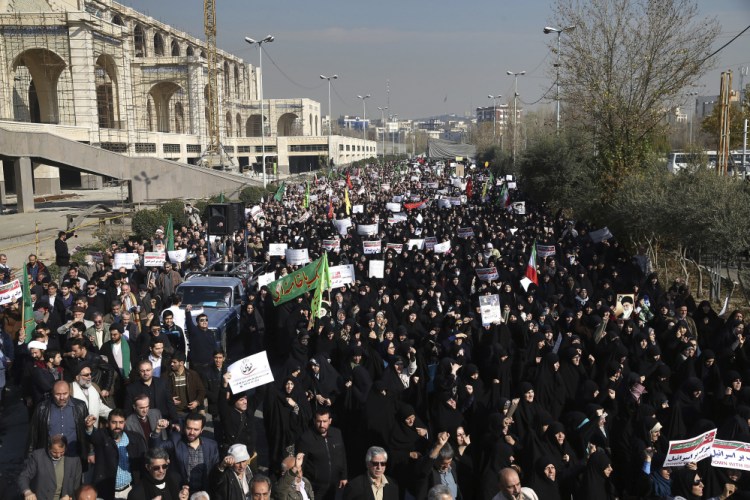ISTANBUL — Anti-government protests in Iran have turned increasingly violent with the deaths of 12 demonstrators and a police officer, raising the stakes as unrest on the streets has raged now for five days and confounded leaders who have struggled to respond.
The protests have been stunning in their ferocity and geographic reach, spreading to far-flung towns and cities that are strongholds of the middle and working class.
The demonstrators themselves appeared Monday to be leaderless, and their demands diffuse, ranging from better living conditions to more political freedoms and even an end to the Islamic Republic. Their chants and attacks on government buildings broke taboos in a system that brooks little dissent. The demonstrations were the boldest challenge to government authority since a pro-democracy revolt in 2009.
The prospect of a harsher response from security forces, whose brutality is notorious, raised fears of further violence in a country buffeted by conflict elsewhere in the region. Iran has sent cash, weapons, and fighters to prop up proxies and allies from Syria to Lebanon and Gaza – and that, too, has become a focus of the protests. The country’s expensive foreign policy adventures were scorned as some demonstrators chanted “Leave Syria, think about us!”
At least 10 people were killed overnight, in what state media said Monday were clashes between police and “armed protesters” who had tried to infiltrate security outposts. The demonstrators were from provincial areas in the south and southwestern parts of the country, including both impoverished and oil-producing regions.
One police officer was killed and three others wounded by a gunman in the city of Najafabad, about 200 miles south of Tehran, according to state media reports. Earlier, activists had said that two demonstrators were shot and killed Saturday during peaceful protests.
Videos circulated online of protesters fleeing tear gas and water cannons, while others confronted police. On Monday, demonstrators again gathered in Tehran, as well as an array of provincial cities, including Kermanshah in the west and Shiraz in central Iran, according to reports on social media. They chanted “Death to the dictator!” – referring to Supreme Leader Ali Khamenei – and called on security forces to join them.
This brought a strong rebuke from the country’s judicial chief. “I demand all prosecutors across the country to get involved,” said Ayatollah Sadegh Larijani, the Associated Press reported. Their “approach should be strong,” he said.
“When it comes to regime survival, Khamenei calls the shots,” Cliff Kupchan, chairman of a political risk firm called Eurasia Group, said in a briefing note. “And he’s got a lot of loyal and ruthless troops at his disposal.”
The unrest began Thursday in the northern city of Mashhad over price hikes and other economic woes. Iran’s economy had been battered by years of U.S. and international sanctions, which isolated the Islamic Republic for its nuclear program. Many of those sanctions were lifted as part of a nuclear deal with world powers in 2015, but few Iranians have benefitted from the relief.
Iran’s economy has grown since the nuclear deal thanks to resumed oil exports, but non-oil sector growth has sagged.
In contrast to the 2009 uprising – which challenged the reelection of President Mahmoud Ahmadinejad, and was driven primarily by Tehran’s educated elite – the current protests have occurred throughout the country and in traditional government strongholds.
The pro-reform figures associated with the 2009 revolt – some of whom remain under house arrest – have been noticeably absent from the political scene since the new protests began. Demonstrators, too, have refrained from calling for the release of those figures and some of Iran’s most well-known opposition leaders.
Send questions/comments to the editors.



Comments are no longer available on this story